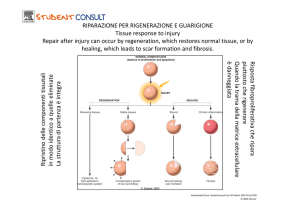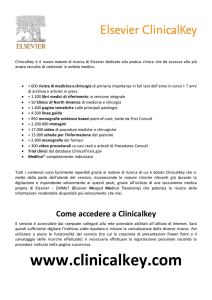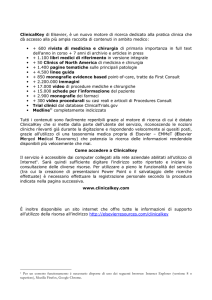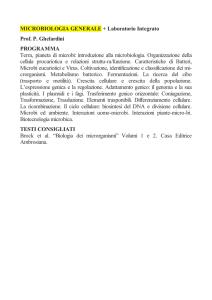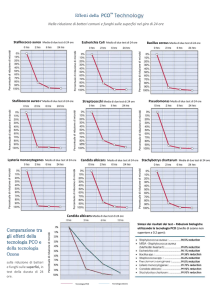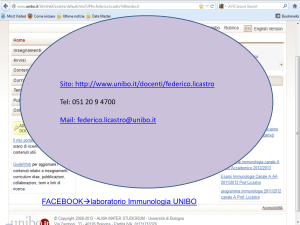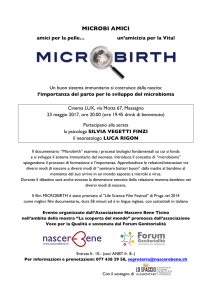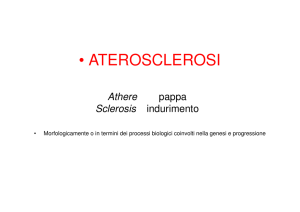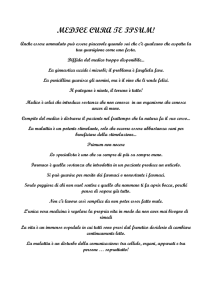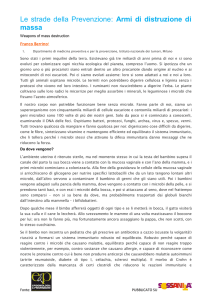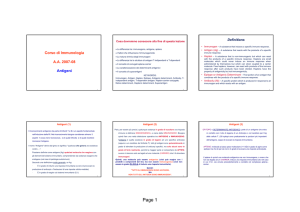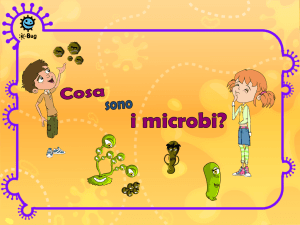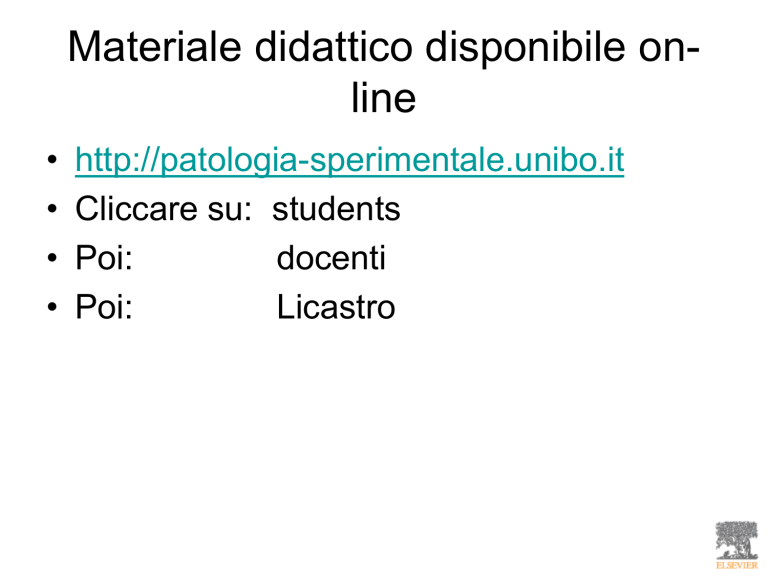
Materiale didattico disponibile online
•
•
•
•
http://patologia-sperimentale.unibo.it
Cliccare su: students
Poi:
docenti
Poi:
Licastro
IL SISTEMA IMMUNITARIO
• IMMUNOLOGIA DERIVA DA IMMUNE
• IMMUNE VUOL DIRE ESSERE LIBERO
DA MALATTIE INFETIVE
• L’IMMUNOLOGIA E’ LA DISCIPLINA CHE
STUDIA I MECCANISMI DIFENSIVI CHE
CI RENDONO IMMUNI O LIBERI DA
MALATTIE INFETTIVE
• CONDIVIDIAMO L’AMBIENTE CON I
MICRORGANISMI
Evoluzione del sistema
linfoide
Spugne
Molluschi, Tunicati
e echinodermi
Cellule mesenchimali
Cellule linfoidi
primitive
Linfociti T e B
Vertebrati
Organi linfatici
primari (timo) e
secondari (noduli
linfatici, linfonodi e milza)
Evoluzione del sistema immunitario
fagocitosi
IgM
IgM, IgG
Evoluzione del sistema immunitario
IgM, IgG, IgA
IgM, IgG, IgA, IgD, IgE
RISPOSTA IMMUNITARIA INNATA e ADATTATIVA
I meccanismi della risposta immunitaria
INNATA sono la prima linea di difesa
dell’organismo contro le infezioni.
La risposta immunitaria ADATTATIVA si sviluppa
invece
in
un
secondo
momento
e
consiste
principalmente
nell’attivazione dei linfociti.
IMMUNITA’ INNATA
Immunità innata
E’’ costituita da una serie di meccanismi di
difesa
non
antichi,
individuo.
specifici,
presenti
Questi
fin
sono
evoluzionisticamente
dalla
nascita
presenti
già
di
un
prima
dell’esposizione all’antigene e rappresentano la
prima vera barriera di difesa dell’organismo
agli agenti patogeni.
Componenti
Funzioni principali
Barriere
Strato epiteliale
Prevenzione dell’entrata dei microbi
Defensine
Uccisione dei microbi
Linfociti intraepiteliali
Uccisione dei microbi
Cellule effettrici circolanti
Neutrofili
Fagocitosi e uccisione dei microbi
Macrofagi
Fagocitosi e uccisione dei microbi,
Secrezione di citochine che stimolano infiammazione
Cellule NK
Lisi delle cellule infettate, attivazione dei macrofagi
Proteine effettrici circolanti
Complemento
Uccisione e opsonizzazione microbi,
Attivazione dei leucociti
Lectina che lega il mannosio (collectina)
Opsonozzazione microbi, attivazione del complemento
(via lectinica)
Proteina C-reattiva (pentraxina)
Opsonizzazione microbi, attivazione complemento
Fattori di coagulazione
Isolano I tessuti infetti
Citochine
TNF, IL-1, chemochine
Infiammazione
IFN-a, -b
Resistenza a infezioni virali
IFN-g
Attivazione macrofagi
IL-12, IL-18, IL-23
Produzione di IFN-g da cellule NK e T
IL-15
Proliferazione cellule NK
IL-10, TGF-b
Controllo dell’infiammazione
Vie di infezione dei patogeni
BARRIERE EPITELIALI
Gli epiteli presenti nel luogo d’entrata dei microbi esercitano la funzione di barriera fisica,
producono sostanze antimicrobiche e contengono linfociti intraepiteliali che uccidono microbi
e le cellule infette
Barriere epiteliali intrinseche
contro le infezioni
Meccaniche
Cellule epiteliali unite dalle
giunzioni strette.
Movimento del muco mediante le
ciglia
Chimiche
Acidi grassi
Enzimi: lisozima, pepsina
pH
Peptidi antibatterici
Microbiologiche
La flora compete per i nutrienti
e per l’attacco all’epitelio e può
produrre sostanze antibatteriche.
CELLULE E TESSUTI DEL
SISTEMA IMMUNITARIO
Cellule dell’ Immunità Innata
•Granulociti
(Fagocitosi )
•Monociti
(Fagocitosi )
•Macrofagi
(Fagocitosi )
•Cellule dendritiche
Cellule Natural Killer (NK o LGL): Citotossicità
Numero assoluto e percentuali dei
leucociti nel sangue (Esame
emocromocitometrico completo)
Globuli Bianchi: 4000-6000/mm3
Granulociti Neutrofili:
>55%
Granulociti Basofili:
1%
Granulociti Eosinofili:
1%
Monociti:
3%
• Linfociti T e B:
20%
• Linfociti non T non B (NK): 20%
Granulocita neutrofilo
Morphology of neutrophils. The light micrograph of a blood neutrophil shows the multilobed nucleus, because of which these cells are also called
polymorphonuclear leukocytes, and the faint cytoplasmic granules.
Downloaded from: StudentConsult (on 23 September 2008 03:22 PM)
© 2005 Elsevier
Figure 2.5 At the ultrastructural level, the azurophilic (primary) granules are larger than the secondary (specific) granules with a strongly electron-dense matrix; the
majority of granules are specific granules and contain a variety of toxic materials to kill microbes. A pseudopod (to the right) is devoid of granules. Arrows indicate nuclear
pores. (Go, Golgi region) Inset: A mature neutrophil in a blood smear showing a multilobed nucleus. × 1500. (From Zucker-Franklin D, Grossi CE, eds. Atlas of
blood cells: function and pathology, 3rd edn. Milan: Edi Ermes; 2003)
Downloaded from: StudentConsult (on 2 April 2008 09:53 AM)
© 2005 Elsevier
Granulocita basofilo
Downloaded from: StudentConsult (on 11 May 2006 01:29 PM)
© 2005 Elsevier
Figure 2.8 Ultrastructural analysis shows a segmented nucleus (N) and the large cytoplasmic granules (G). Arrows indicate nuclear pores. × 11 000. (Adapted from
Zucker-Franklin D, Grossi CE, eds. Atlas of blood cells: function and pathology, 3rd edn. Milan: Edi Ermes; 2003) Inset: This blood smear shows a typical basophil with its
deep violet-blue granules. × 1000.
Downloaded from: StudentConsult (on 2 April 2008 09:53 AM)
© 2005 Elsevier
Downloaded from: StudentConsult (on 11 May 2006 01:29 PM)
© 2005 Elsevier
Morphology of mononuclear phagocytes. A. Light micrograph of a monocyte in a peripheral blood smear. B. Electron micrograph of a peripheral blood
monocyte. (Courtesy of Dr. Noel Weidner, Department of Pathology, University of California, San Diego.) C. Electron micrograph of an activated tissue
macrophage showing numerous phagocytic vacuoles and cytoplasmic organelles. (From Fawcett DW. Bloom & Fawcett's Textbook of Histology, 12th ed.
Chapman & Hall, 1994. With kind permission of Springer Science and Business Media.)
Downloaded from: StudentConsult (on 23 September 2008 02:30 PM)
© 2005 Elsevier
Figure 2.4 Ultrastructure of a monocyte showing the horseshoe-shaped nucleus, pinocytotic vesicles (PV), lysosomal granules (G), mitochondria (M), and isolated rough
endoplasmic reticulum cisternae (E). × 8000. (Courtesy of Dr B Nichols) Inset: Light microscope image of a monocyte from the blood. × 1200.
Downloaded from: StudentConsult (on 2 April 2008 09:53 AM)
© 2005 Elsevier
Maturation of mononuclear phagocytes. Mononuclear phagocytes develop in the bone marrow, circulate in the blood as monocytes, and are resident in all
tissues of the body as macrophages. They may differentiate into specialized forms in particular tissues. CNS, central nervous system.
Downloaded from: StudentConsult (on 23 September 2008 02:30 PM)
© 2005 Elsevier
Circulating monocytes give rise to myeloid dendritic cells (distinct from plasmacytoid dendritic cells, which are thought to originate from distinct precursors),
tissue macrophages, and osteoclasts. F4/80 and FA/11 (macrosialin, the murine homolog of CD68) are differentiation antigens of mouse macrophages and
closely related cells.
Downloaded from: StudentConsult (on 23 September 2008 02:44 PM)
© 2005 Elsevier
Resident tissue macrophage populations.
Downloaded from: StudentConsult (on 23 September 2008 02:44 PM)
© 2005 Elsevier
Microglia are widely distributed in non-overlapping fields and show a dendritic morphology. (Courtesy of Dr Payam Rezaie)
Downloaded from: StudentConsult (on 23 September 2008 02:44 PM)
© 2005 Elsevier
Recettori per i patogeni sulle cellule
dell’immunità innata
• Esistono numerose famiglie di recettori.
• Queste molecole recettoriali riconoscono
motivi molecolari comuni a molte sostanze
presenti sulla superficie dei patogeni.
• Il riconoscimento non è limitato o specifico
per una sostanza ma allargato a gruppi di
sostanze o molecole presenti sui
microrganismi.
Figure 2-3
Downloaded from: StudentConsult (on 23 September 2008 02:30 PM)
© 2005 Elsevier
Recettori per il riconoscimento dei microrganismi impiegati dai macrofagi e fagociti.
Downloaded from: StudentConsult (on 23 September 2008 02:30 PM)
© 2005 Elsevier
The mannose receptor contains eight C-type lectin domains involved in binding to mannosylated carbohydrates and related glycoconjugates. It is related to a
more broadly expressed endocytic receptor, ENDO 180. A distinct lectin domain located in the distal (C terminal) segment binds sulfated glycoconjugates.
The β-glucan receptor (dectin-1) contains a single lectin domain and an intracellular immunoreceptor tyrosine-based activation motif (ITAM). DC-SIGN
(another mannose-binding C-type lectin) has four associated lectin domains.
Downloaded from: StudentConsult (on 23 September 2008 02:44 PM)
© 2005 Elsevier
Selected scavenger receptors are shown. Scavenger receptors of macrophages are responsible for the uptake of apoptotic cells, modified lipoproteins, and
other polyanionic ligands (e.g. LPS and lipoteichoic acids [LTA]), as well as selected bacteria such as Neisseria spp. CD163 is involved in endocytosis of
hemoglobin-haptoglobin complexes.
Downloaded from: StudentConsult (on 23 September 2008 02:44 PM)
© 2005 Elsevier
Mammalian TLRs: specificities, basic signaling mechanisms, and cellular responses. Ligands for TLRs are shown together with dimers of the TLRs that
specially bind them. Note that some TLRs are expressed in endosomes and some on the cell surface (see Fig. 2-7). The basic steps in TLR signaling,
illustrated only for TLR3 and TLR4, are applicable to all TLRs. Further details about the signaling pathways are described in Box 2-1.
Downloaded from: StudentConsult (on 23 September 2008 02:30 PM)
© 2005 Elsevier
Cellular locations of pattern recognition molecules of the innate immune system. Some pattern recognition molecules of the TLR family (see Fig. 2-7), such as
TLRs 2, 4, and 5, are expressed on the cell surface, where they may bind extracellular pathogen-associated molecular patterns. Other TLRs are expressed on
endosomal membranes, such as TLRs 3, 7, 8, and 9, all of which can recognize nucleic acids of microbes that have been phagocytosed by cells. Cells also
contain cytoplasmic sensors of microbial infection (discussed later in the chapter), including the NLR family of proteins, which recognize bacterial
peptidoglycans, and a subset of CARD family of proteins, which bind viral RNA.
Downloaded from: StudentConsult (on 23 September 2008 02:30 PM)
© 2005 Elsevier
Effector functions of macrophages. Macrophages are activated by microbial products such as LPS and by NK cell-derived IFN-γ (described later in
the chapter). The process of macrophage activation leads to the activation of transcription factors, the transcription of various genes, and the synthesis of
proteins that mediate the functions of these cells. In adaptive cell-mediated immunity, macrophages are activated by stimuli from T lymphocytes (CD40 ligand
and IFN-γ) and respond in essentially the same way (see Chapter 13, Fig. 13-14).
Downloaded from: StudentConsult (on 23 September 2008 02:30 PM)
© 2005 Elsevier
Recettori per le opsonine
• Recettori per il componente C3b del
complemento.
• Recettori per il frammento cristallizabile
(Fc) delle Immunoglobuline IgG e IgM.
Pathogens, such as bacteria, are taken up by binding to opsonic receptors including the Fc receptor, complement receptors, and receptors for carbohydrate
(MR). (2) The particle is engulfed and the phagosome forms (3). Acidification of the phagosome follows as toxic molecules (reactive oxygen and nitrogen
intermediates) are pumped into the phagosome. The marker FA/11 is located in the phagosome membrane. (4) Lysosomes fuse with the phagosome,
releasing proteolytic enzymes into the phagolysosome, which digest the bacteria. (5) On completion the membrane of the phagolysosome is disrupted.
Antigenic fragments may become diverted to the acidic endosome compartment for interaction with MHC class II molecules and antigen presentation. The
process induces secretion of toxic molecules and cytokines.
Downloaded from: StudentConsult (on 23 September 2008 02:44 PM)
© 2005 Elsevier
La Fagocitosi
FAGOCITOSI E
DISTRUZIONE
INTRACELLULARE DEI
MICROBI
I microbi si possono legare a diversi
recettori di membrana presenti sui
fagociti; alcuni di questi recettori
legano direttamente i microbi, altri
invece legano i microbi opsonizzati.
I microbi vengono internalizzati in
fagosomi, che si fondono poi con i
lisosomi per formare i fagolisosomi
all’interno dei quali i microbi vengono
uccisi
dagli
intermedi
reattivi
dell’ossigeno e dell’ossido nitrico.
Meccanismi di uccisione dei
patogeni
Meccanismi O dipendenti: produzione di ROS
(radicali attivi dell’ossigeno) come l’ossigeno singoletto.
Questo composto è poi in grado di produrre composti
altamente battericidi come il perossido d’idrogeno e il
radicale ossidrilico
Meccanismi Ossigeno indipendenti: l’uccisione avviene
tramite diverse sostanze contenute nei lisosomi: il
lisozima, le proteine cationiche, le defensine e la
lattoferrina.
Meccanismi Azoto dipendenti: anche in questo caso
si formano nei composti reattivi dell’azoto in grado di
produrre composti battericidi.
RECETTORI E RISPOSTE DEI FAGOCITI
I neutrofili e I macrofagi hanno recettori di membrana diversi per riconoscere I microbi, I prodotti
microbici e sostanze prodotte dagli ospiti durante l’infezione. Questi recettori attivano delle risposte
cellulari che hanno la funzione di stimolare l’infiammazione e eradicare I microbi.
Figure 1.18 At a site of inflammation, tissue damage and complement activation cause the release of chemotactic peptides (e.g. chemokines and C5a), which diffuse to
the adjoining venules and signal to circulating phagocytes. Activated cells migrate across the vessel wall and move up a concentration gradient of chemotactic molecules
towards the site of inflammation.
Downloaded from: StudentConsult (on 23 September 2008 03:29 PM)
© 2005 Elsevier
RECLUTAMENTO DEI LEUCOCITI
Nel sito di infezione I macrofagi che hanno incontrato microbi iniziano a produrre citochine (TNF e IL-1)
le quali attivano le cellule endoteliali dei vasi circostanti a produrre selectine, ligandi per le integrine e
chemochine. Le selectine promuovono un debole legame sui leucociti (neutrofili) circolanti facendoli
rotolare sulla parete; le integrine invece mediano una adesione più forte dei neutrofili e le chemochine
ne aumentano l’affinità di legame, e stimolano l.a migrazione delle cellule dall’endotelio verso il sito di
infezione.
Neutrofili, monociti e linfociti T attivati circolanti usano essenzialmente questi stessi meccanismi per
raggiungere il sito di infezione.

